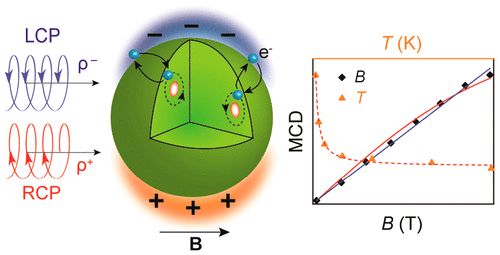Our official English website, www.x-mol.net, welcomes your
feedback! (Note: you will need to create a separate account there.)
Controlling the Mechanism of Excitonic Splitting in In2O3 Nanocrystals by Carrier Delocalization
ACS Nano ( IF 15.8 ) Pub Date : 2018-10-15 00:00:00 , DOI: 10.1021/acsnano.8b05782 Penghui Yin 1 , Manu Hegde 1 , Yi Tan 1 , Shuoyuan Chen 1 , Natalie Garnet 1 , Pavle V. Radovanovic 1
ACS Nano ( IF 15.8 ) Pub Date : 2018-10-15 00:00:00 , DOI: 10.1021/acsnano.8b05782 Penghui Yin 1 , Manu Hegde 1 , Yi Tan 1 , Shuoyuan Chen 1 , Natalie Garnet 1 , Pavle V. Radovanovic 1
Affiliation

|
Degenerately doped metal oxide nanocrystals have emerged as infrared plasmonic materials with promising applications in optoelectronics, surface-enhanced infrared spectroscopies, and sensing. They also have potential for technological applications in electronics and photonics owing to the possibility of coupling between plasmon and exciton in the absence of a heterojunction. Here, we demonstrate the control of excitonic splitting in In2O3 nanocrystals upon excitation with circularly polarized light in an external magnetic field by simultaneous control of the electronic structure of donor defects and the nanocrystal host lattice. Using variable-temperature–variable-field magnetic circular dichroism spectroscopy, we show that the nanocrystal band splitting has two distinct contributions in plasmonic In2O3 nanocrystals. Temperature-independent splitting arises from the cyclotron magnetoplasmonic modes, which impart angular momentum to the conduction band excited states near the Fermi level, and increases with the intensity of the corresponding plasmon resonance. Temperature-dependent splitting is associated with the localized electron spins trapped in defect states. The ratio of the two components can be controlled by the formation of oxygen vacancies or introduction of aliovalent dopants. Using these experimental results in conjunction with the density functional theory modeling, relative contribution of the two mechanisms is discussed in the context of the perturbation theory taking into account energy separation between the nanocrystal excited states and the localized defect states. The results of this work demonstrate the ability to control carrier polarization in nonmagnetic metal oxide nanocrystals using both individual and collective electronic properties and allow for their application as an emerging class of multifunctional materials with strongly interacting degrees of freedom.
中文翻译:

载流子离域控制In 2 O 3纳米晶体中激子分裂的机理
简并掺杂的金属氧化物纳米晶体已成为红外等离激元材料,在光电子学,表面增强红外光谱学和传感领域具有广阔的应用前景。由于在不存在异质结的情况下等离激元和激子之间的耦合的可能性,它们在电子和光子学中也具有技术应用的潜力。在这里,我们演示了In 2 O 3中激子分裂的控制通过同时控制施主缺陷和纳米晶体主体晶格的电子结构,在外部磁场中用圆偏振光激发纳米晶体。使用可变温度-可变场圆圆二色性光谱,我们表明,纳米带分裂对等离子体In 2 O 3具有两个不同的贡献纳米晶体。与温度无关的分裂是由回旋加速器的磁等离子体模式引起的,该模式将角动量赋予费米能级附近的导带激发态,并随相应等离子体共振的强度而增加。与温度有关的分裂与陷于缺陷状态的局部电子自旋有关。可以通过形成氧空位或引入铝价掺杂剂来控制两种组分的比例。将这些实验结果与密度泛函理论建模相结合,在微扰理论的背景下讨论了两种机理的相对贡献,其中考虑了纳米晶体激发态与局部缺陷态之间的能量分离。
更新日期:2018-10-15
中文翻译:

载流子离域控制In 2 O 3纳米晶体中激子分裂的机理
简并掺杂的金属氧化物纳米晶体已成为红外等离激元材料,在光电子学,表面增强红外光谱学和传感领域具有广阔的应用前景。由于在不存在异质结的情况下等离激元和激子之间的耦合的可能性,它们在电子和光子学中也具有技术应用的潜力。在这里,我们演示了In 2 O 3中激子分裂的控制通过同时控制施主缺陷和纳米晶体主体晶格的电子结构,在外部磁场中用圆偏振光激发纳米晶体。使用可变温度-可变场圆圆二色性光谱,我们表明,纳米带分裂对等离子体In 2 O 3具有两个不同的贡献纳米晶体。与温度无关的分裂是由回旋加速器的磁等离子体模式引起的,该模式将角动量赋予费米能级附近的导带激发态,并随相应等离子体共振的强度而增加。与温度有关的分裂与陷于缺陷状态的局部电子自旋有关。可以通过形成氧空位或引入铝价掺杂剂来控制两种组分的比例。将这些实验结果与密度泛函理论建模相结合,在微扰理论的背景下讨论了两种机理的相对贡献,其中考虑了纳米晶体激发态与局部缺陷态之间的能量分离。











































 京公网安备 11010802027423号
京公网安备 11010802027423号